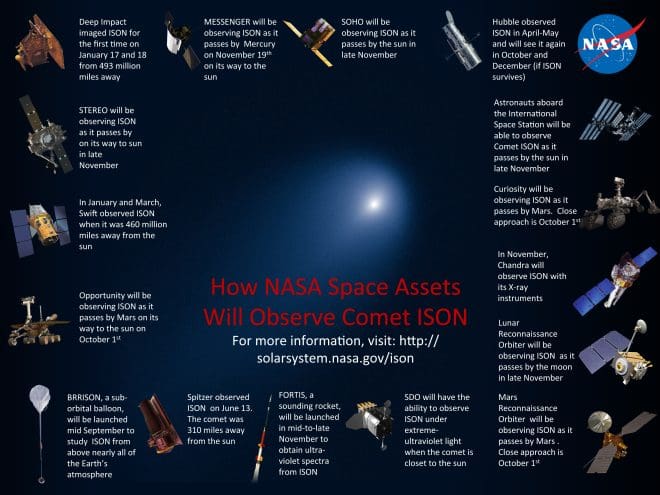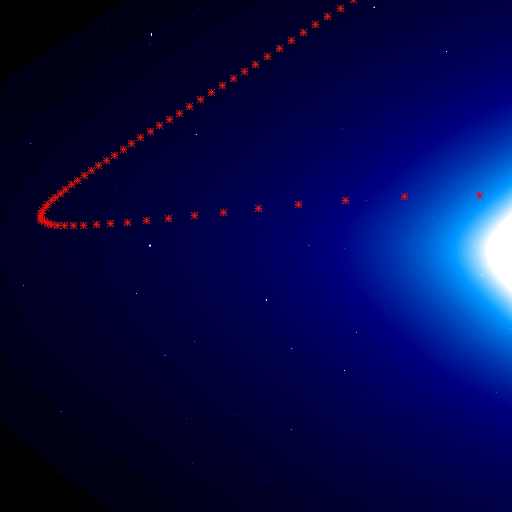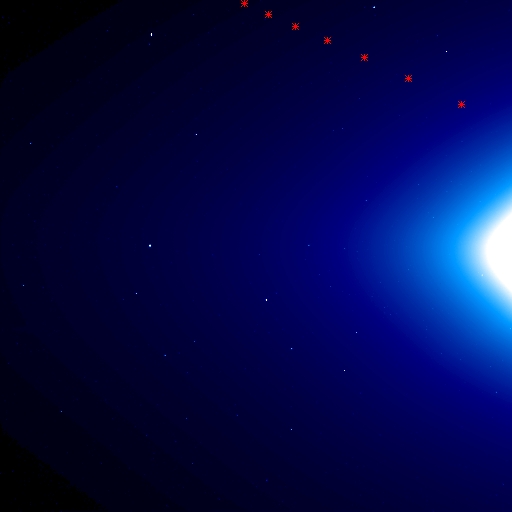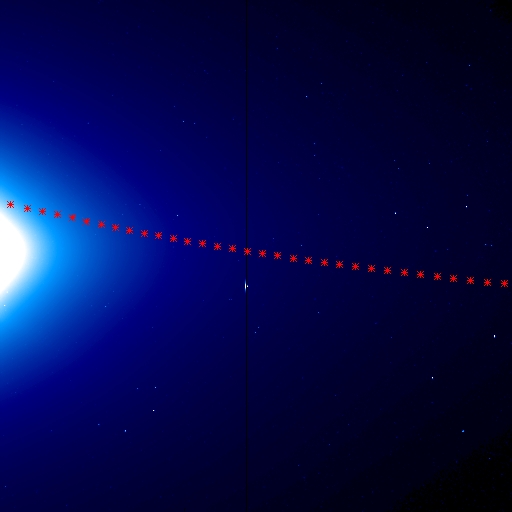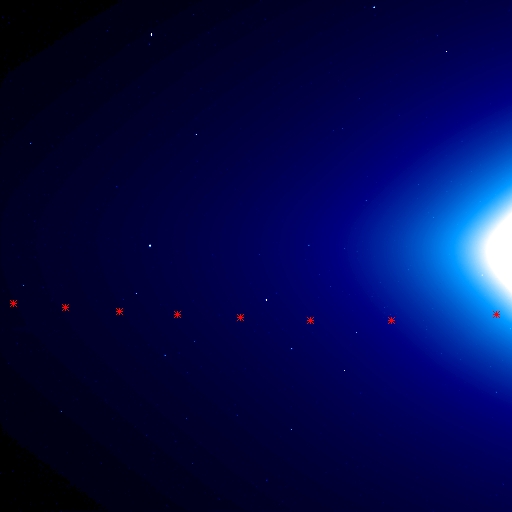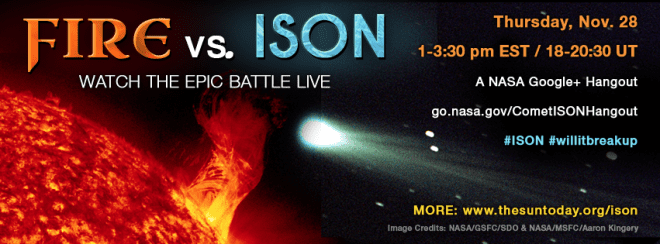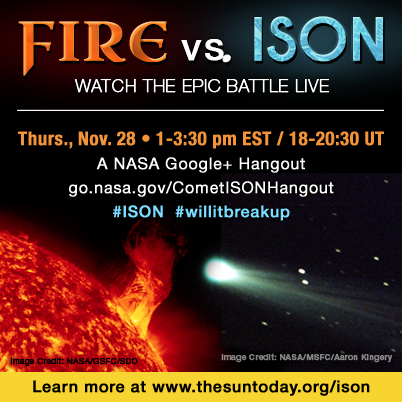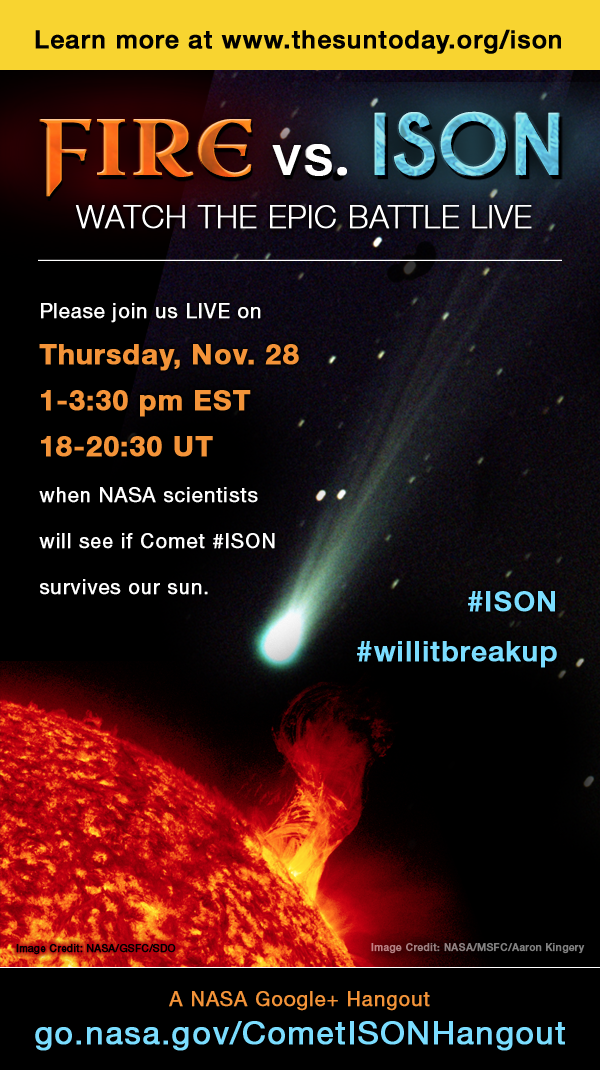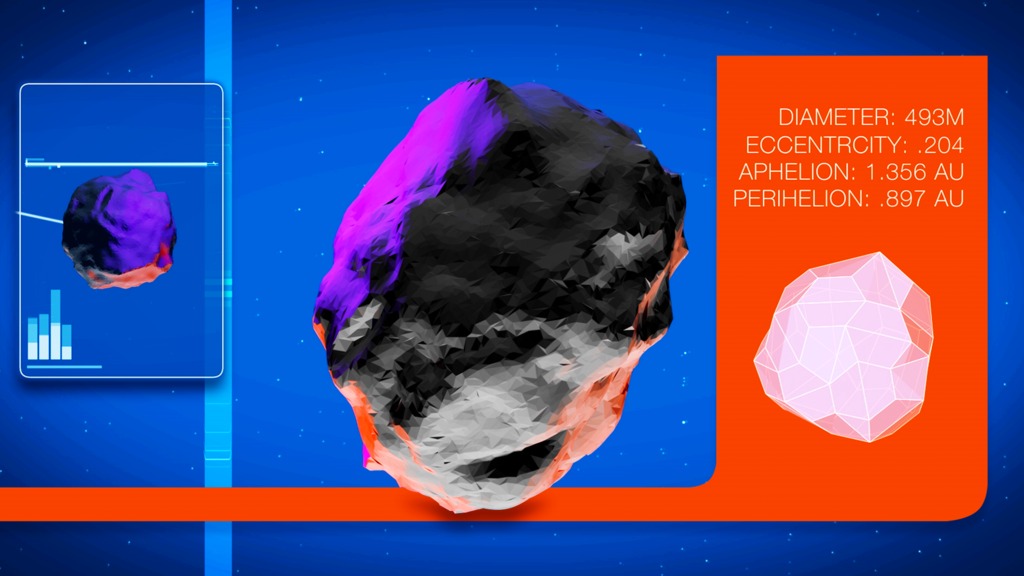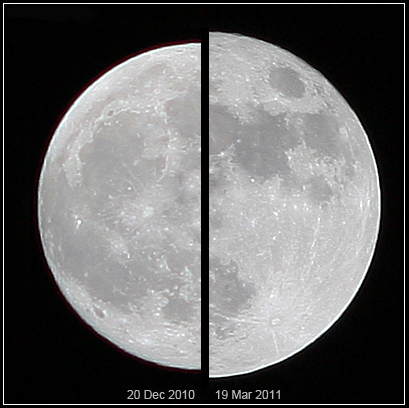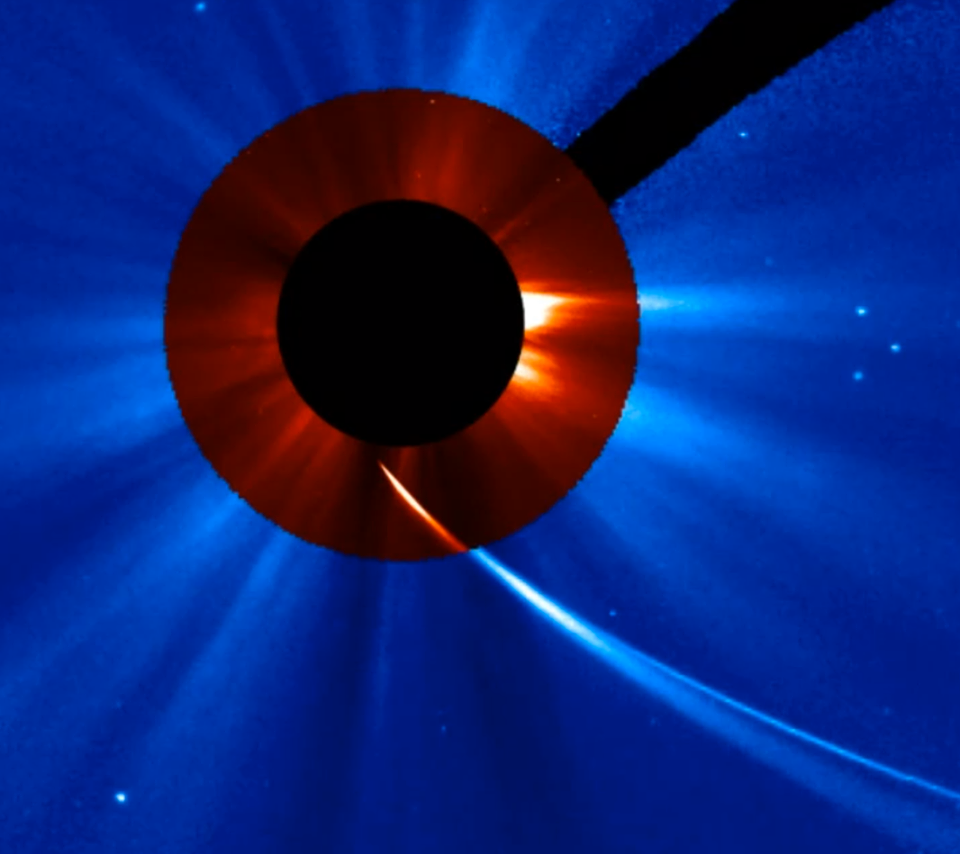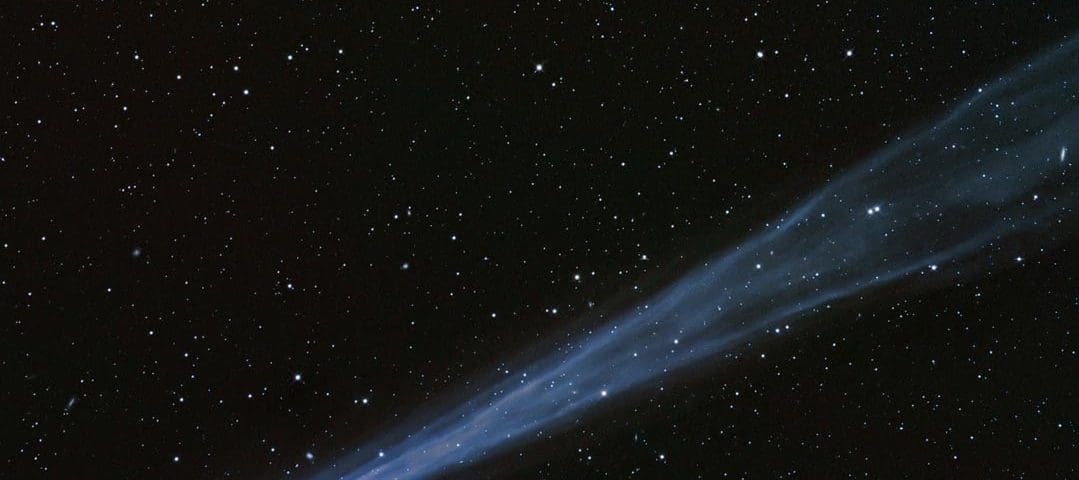

Amateur astronomer Waldemar Skorupa captured this picture of ISON from Kahler Asten, Germany (shared by spaceweather.com)
Current Status of Comet ISON
Updated Nov. 27, 2013 – 10:40 am EST or 15:40 UT
Size
1.3 mi in diameter or 2 in diameter km
| Date and Time of Perihelion | 28 November 2013, 18:38 UT (1:38 EST) |
| Distance from the sun at Perihelion |
1,167,615 mi or 1,877,850 km |
| Speed at Perihelion |
843,500 mph or 1,357,400 kph |
| Current Speed | 317,380 mph or 510,800 kph |
| Current Distance to the sun |
8,471,200 mi or 13,631,000 km |
| Current Distance to Earth |
88,757,000 mi or 142,842,900 km |
Comet ISON is fast approaching the culmination of its journey towards and hopefully around the sun. On November 28, 2013 at 18:45 UT (1:45 EST) ISON reaches perihelion (closest solar approach) and scientists can’t wait.
Comet ISON (C/2012 S1) is a sungrazing comet that was discovered by Vitali Nevski and Artyom Novichonok on September 21, 2012 using as part of the International Scientific Optical Network (ISON).
Comet ISON Gallery
Click on an image below to view larger.
Comet Encounter on PBS – featuring Dr. C. Alex Young
What is a Sungrazing Comet?
Because ISON is a sungrazing comet it is of immediate interest to solar scientists. But what makes ISON really exciting is that the comet is large enough in size that it has a good chance of surviving its journey past perihelion (closest solar approach). Most sungrazing comets are completely destroyed during the closest approach to the sun. The intense solar radiation, solar wind and huge tidal forces usually spell certain destruction for most sungrazers. In fact, the now famous Comet Lovejoy survived its journey around the sun and scientist captured all of this with several spacecraft normally designed just to look at the sun not comets.
ISON promises to possibiltiy be even more spectacular as it is estimated to be larger than Lovejoy. Simply put is has more stuff and so it has a better chance of surviving its perilous journey near the sun.
As ISON gets closer to the sun it will continue to brighten. More observers on the ground and more missions in space will see the comet as it brightens.
By November 7, 2013, ISON has been observed by 8 different spacecraft including the solar missions, SOHO and STEREO (both STEREO-A and STEREO-B).

Comet #ISON observed by 8 spacecraft and counting! A quick look at the 8, http://bit.ly/1iOXfIr credit: NASA/ESA/ISON campaign
On November 8, 2013 ISON was about 0.8 AU (74 million m, 120 million km) from the sun, traveling 47 km/s (105,000 mph, 169,000 kph), shedding ~16 Olympic-sized pools of water per day. The average coronal mass ejection (CME) is traveling at speeds ~10-20 times faster and is made of ~1 billion tons of stuff, equal to ~ 400,000 Olympic-sized pools of water.
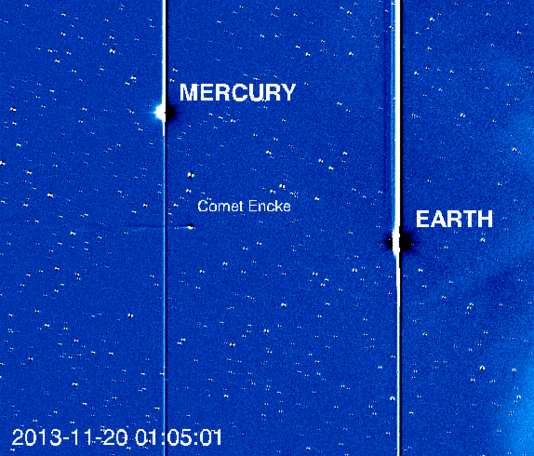
Image Credit: Karl Battams/NASA/STEREO/CIOC
How NASA Space Assets Will Observe Comet ISON
The main solar missions that are and will be observing ISON as it makes its journey around the sun are the SOHO, STEREO and SDO missions. These missions have all coordinated their observations to get the best possible data of the comet possible. The NASA Comet ISON Observing Campaign has outlined the basic plan on their website. In addition the STEREO team has outlined their plans for the SOHO and STEREO observations on their site. The SDO team on their external blog and on the Know Your Night Sky site. SDO also has a site dedicated to the near-realtime data they plan to receive.
NASA has quite space fleet tracking ISON:
| Solar Dynamics Observatory | Observing ISON under extreme-ultraviolet light when the comet is closest to the sun. |
| SOHO | Observing ISON as it passes by the sun in late November. |
| STEREO | Observing ISON as it passes by on its way to sun in late November. |
| MESSENGER | Observing ISON as it passes by Mercury on November 19th on its way to the sun. |
| BRRISON | Sub-orbital balloon that will be launched mid September to study ISON from above nearly all of the Earth’s atmosphere. |
| FORTIS | Sounding rocket that will be launched in mid-to-late November to obtain ultra-violet spectra from ISON. |
| Hubble Space Telescope | Observed ISON in April-May and will see it again in October and December (if ISON survives). |
| Spitzer Space Telescope | Observed ISON on June 13. The comet was 310 million miles away from the sun. |
| Chandra X-ray Observatory | Observing ISON’s interactions with the solar wind. |
| International Space Station | Astronauts will be able to observe Comet ISON as it passes by the sun in late November. |
| Lunar Reconnaissance Orbiter | Observing ISON as it passes by the moon in late November. |
| Swift | In January and March, Swift observed ISON when it was 460 million miles away from the sun. |
| Curiosity | Observing ISON as it passes by Mars. Closest approach is October 1st. |
| Opportunity | Observing ISON as it passes by Mars on its way to the sun on 1 October. |
| Mars Reconnaissance Orbiter | Observing ISON as it passes by Mars. Closest approach is October 1st. |
| Deep Impact | Imaged ISON for the first time on January 17 and 18 from 493 million miles away. |
Ground-Based Observers
| Amateur Astronomer | You – with a telescope or binoculars in November. |
| Research Telescopes | NASA Infrared Telescope Facility, Keck Observatory and many more. |
What will SDO see?
There’s also a possibility that the Solar Dynamics Observatory (SDO) satellite might be able to observe Comet ISON in extreme-ultraviolet when it’s closest to the Sun. However, at the currently estimated apparent distance of 1.8 solar radii, SDO would have to point away from the Sun to see the comet. In order to make these observations possible the SDO team has develop a detailed plan to point the spacecraft away from sun centered pointing. The “off-pointing” of SDO will take place in 3 stages. There is one pointing for ION’s approach, one during perihelion and one for its departure. Below is a diagram showing the predicted orbit of ISON as it passes the sun. Boxes mark the 3 different fields-of-view of SDO as it moves to follow the comet’s path. Each time the spacecraft moves to a new pointing there is a short period needed for the spacecraft to settle to minimize movement of the camera. There is also an animation of the observation plan. It shows the pointing and field-of-view for SDO as ISON passes the sun. For more about SDO check out their external blog and the Know Your Night Sky site.
What will STEREO see?
STEREO and SOHO are expected to provide extensive coverage of ISON’s trip near the sun. The STEREO team has created a great set of images showing ISON’s predicted position before, during and after perihelion for the two STEREO spacecraft and the SOHO spacecraft. Here are the main predicted observations but the STEREO page provides a much more detailed discussion of what STEREO and SOHO should see. In addition to these images, the STEREO page has 2 different tools to look at ISON’s orbit.
Leading up to the Big Day
Around and Near Perihelion
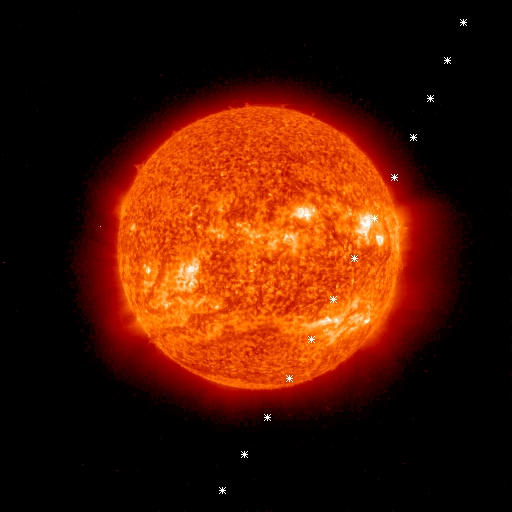
Predicted position of Comet ISON in the EUVI-B field-of-view in ten-minute intervals between 17:50 UT and 20:00 UT on November 28, 2013. (credit: NASA/STEREO)
After Perihelion
What will SOHO see?
The LASCO C2 and C3 coronagraphs on the Solar and Heliospheric Observatory (SOHO) satellite will also have a view of the comet as it passes through their fields-of-view, as shown below. From SOHO’s viewpoint the comet enters from the lower right early on November 27 and exits towards the top near the end of November 30.

Predicted hour-by-hour position of Comet ISON in the LASCO C3 (blue) and C2 (red) fields-of-view on SOHO, November 27-30, 2013. (credit: NASA/STEREO/SOHO)
Help spread the word with social media images!
More Resources for ISON
Below are listed some of the main great resources to follow all the aspects of Comet ISON. Also, The Sun Today’s Alex Young will be at the SDO Mission Operations Center on the day of perihelion to broadcast the event live via a special NASA sponsored Google+ Hangout. Stay tuned for more details as they become available.


